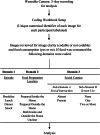The energy density of meals and snacks consumed by young Australian adults (18-30 years old) are influenced by preparation location but not screen use nor social interactions: findings from the MYMeals wearable camera study
- PMID: 36304816
- PMCID: PMC9554418
- DOI: 10.1017/jns.2022.76
The energy density of meals and snacks consumed by young Australian adults (18-30 years old) are influenced by preparation location but not screen use nor social interactions: findings from the MYMeals wearable camera study
Abstract
The present study examined the association of contextual factors (social and food preparation location) with the energy density of meals and snacks consumed in a sample of young Australian adults (18-30 years old) identified using wearable camera technology. Over three consecutive days, a subsample of young adults wore a wearable camera that captured images in 30 s intervals. Eating episodes from 133 participants were annotated for preparation location and social context (covering social interaction and screen use). Over the same period, participants completed daily 24 h recalls. The nutritional composition of meals and snacks was calculated by matching the items identified in the camera to the 24 h recall using time and date stamps. Self-reported data (weight and height) was used to calculate body mass index and (residential postcode) to assign socio-economic status. The association of context and demographic factors with energy density was determined using a mixed linear regression model employing the bootstrap method with bias-corrected and accelerated. In total, 1817 eating episodes were included in the analysis (n 8 preparation unclear and n 15 food components could not be identified excluded). Food prepared within the home was 1⋅1 kJ/g less energy-dense than other preparation locations. Lunches (CI -1⋅7 to -0⋅3) and dinners (CI -1⋅6 to -0⋅5) were both 1⋅0 kJ/g lower in energy density than breakfasts. Snacks were 3⋅5 kJ/g (CI 2⋅8-4⋅1) more energy-dense than breakfasts. Food prepared outside the home and food consumption during snacking appear to be adversely contributing to energy-dense food intake.
Keywords: Dietary assessment; Energy density; Social context; Wearable cameras; Young adults.
© The Author(s) 2022.
Figures


Similar articles
-
The association of social and food preparation location context with the quality of meals and snacks consumed by young adults: findings from the MYMeals wearable camera study.Eur J Nutr. 2022 Oct;61(7):3407-3422. doi: 10.1007/s00394-022-02891-2. Epub 2022 May 6. Eur J Nutr. 2022. PMID: 35523897 Free PMC article.
-
The Frequency and Context of Snacking among Children: An Objective Analysis Using Wearable Cameras.Nutrients. 2020 Dec 30;13(1):103. doi: 10.3390/nu13010103. Nutrients. 2020. PMID: 33396846 Free PMC article. Clinical Trial.
-
Contextual factors influence food intake at eating occasions in young adults: A mixed effect analysis.Appetite. 2024 Dec 1;203:107722. doi: 10.1016/j.appet.2024.107722. Epub 2024 Oct 18. Appetite. 2024. PMID: 39427723
-
The consumption of energy dense snacks and some contextual factors of snacking may contribute to higher energy intake and body weight in adults.Nutr Res. 2021 Dec;96:20-36. doi: 10.1016/j.nutres.2021.11.001. Epub 2021 Nov 20. Nutr Res. 2021. PMID: 34890856 Review.
-
Meals and snacking, diet quality and energy balance.Physiol Behav. 2014 Jul;134:38-43. doi: 10.1016/j.physbeh.2014.03.010. Epub 2014 Mar 19. Physiol Behav. 2014. PMID: 24657181 Review.
Cited by
-
Investigating eating architecture and the impact of the precision of recorded eating time: a cross-sectional study.Am J Clin Nutr. 2025 Mar;121(3):685-694. doi: 10.1016/j.ajcnut.2025.01.012. Epub 2025 Jan 11. Am J Clin Nutr. 2025. PMID: 39805560 Free PMC article.
-
Young Australian Adults Prefer Video Posts for Dissemination of Nutritional Information over the Social Media Platform Instagram: A Pilot Cross-Sectional Survey.Nutrients. 2022 Oct 19;14(20):4382. doi: 10.3390/nu14204382. Nutrients. 2022. PMID: 36297066 Free PMC article.
References
-
- Australian Institute of Health and Welfare (2021) Australian Burden of Disease Study: Impact and Causes of Illness and Death in Australia 2018. Canberra: Australian Institute of Health and Welfare.
-
- Allman-Farinelli MA, Chey T, Bauman AE, et al. (2008) Age, period and birth cohort effects on prevalence of overweight and obesity in Australian adults from 1990 to 2000. Eur J Clin Nutr 62, 898–907. - PubMed
-
- Australian Bureau of Statistics (2018) 4364.0.55.001 - National Health Survey: First Results. https://www.abs.gov.au/statistics/health/health-conditions-and-risks/nat... (accessed 12 August 2021).
Publication types
MeSH terms
LinkOut - more resources
Full Text Sources

